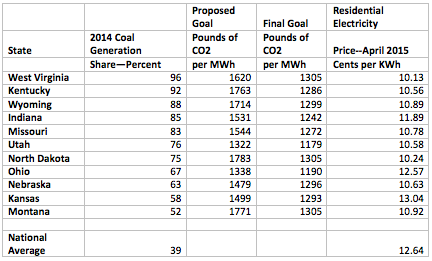President Obama told America in 2008 that “if you want to build a coal plant, you can, but it will bankrupt you.” Now, he is using EPA’s ‘Clean Power Plan’ to hurt the states that generate power largely from coal—states that have the lowest electricity prices in the nation due to their inexpensive and dependable coal-fired generation. President Obama wants to close these coal-fired power plants down prematurely and build wind and solar plants in their place independent of the quality of wind and solar resources in the state. He will be closing plants that generate electricity for a mere 3.84 cents per kilowatt hour and replace them with plants that are about 3 times more expensive.[i] And now, American electricity consumers and taxpayers—who will be providing lucrative subsidies for these new plants—will be footing the bill.
In his fiscal year 2016 budget proposal, President Obama requested Congress to fund the major federal wind subsidy (the production tax credit or PTC as it is commonly called) permanently.[ii] For the past 23 years, the American taxpayer has subsidized wind power to the tune of tens of billions of dollars. The PTC pays the wind operator 2.3 cents for every kilowatt hour that wind energy is produced for the first 10 years of operation. When the PTC was retroactively extended at the end of last year, it was estimated that the retroactive extension alone would cost $6.4 billion.[iii]
The solar industry currently has an investment tax credit that reimburses the owner of a solar project 30 percent of its investment. The 20-percent investment tax credit is available through the end of 2016. In 2017, the tax credit drops to 10 percent of solar investments for commercial projects, which is a permanent tax credit for solar, and expires for residential installations. President Obama’s fiscal year 2016 budget calls for the current 30-percent solar investment tax credit to be extended permanently.[iv]
Change in State Carbon Dioxide Emission Reductions
EPA’s final plan severely affects states with coal-centric generation mixes. The coal-fired generation states clearly lose in the final rule by receiving more stringent carbon dioxide reductions from EPA, while states with more natural gas-fired generation (e.g., Arizona) and under-construction nuclear (e.g., Georgia, Tennessee, and South Carolina) have less stringent carbon dioxide reductions. For example, South Carolina’s carbon dioxide emissions reduction in the final rule is about 50 percent less stringent than in the proposed rule. For many states, the final rule is quite different from the proposed rule as the following graph shows.[v] From the graph, one can see that the states with the most coal-fired generation—those on the left-hand side of the chart—were given more stringent reductions in the final rule, having to reduce their carbon dioxide emissions by the additional amounts shown on the graph.
Electricity Prices of States with Largest Increases in Carbon Dioxide Emissions Reductions
The table below lists the states on the left-hand side of the above chart—the states that were given more stringent carbon dioxide reductions by EPA in the final ‘Clean Power Plan’ rule. As noted above, these states generate the majority of their electricity from coal—between 52 percent (for Montana) and 96 percent (for West Virginia). Except for Kansas—a state that generates 58 percent of its electricity from coal—the residential electricity prices of these 11 states are less than the national average residential electricity price in April 2015 of 12.64 cents per kilowatt hour. The highest electricity price in the lower 48 contiguous states in that month was 22.22 cents per kilowatt hour for Connecticut and the lowest is in Washington State at 8.82 cents per kilowatt hour. Washington generates 68 percent of its electricity from low-cost hydroelectric power, which, according to an IER report, costs 3.42 cents per kilowatt hour to generate electricity.
Sources: http://www.eia.gov/state/rankings/sid=US#/series/31, http://www.eia.gov
/totalenergy/data/monthly/pdf/sec7_5.pdf, http://www.epa.gov/airquality/cpp/cpp-final-rule-ria.pdf, http://americaspower.org/sites/default/files
/NERA_CPP%20Report_Final_Oct%202014.pdf,
http://www.eia.gov/electricity/monthly/current_year/february2015.pdf
An IER report shows that existing coal-fired power plants cost 3.84 cents per kilowatt hour to produce electricity while electricity from new wind power plants costs 10.68 cents per kilowatt hour. And according to the Energy Information Administration, new solar photovoltaic plants cost about 12.53 cents per kilowatt hour to construct.[vi] So, it is easy to see from these figures, if the United States is going to prematurely retire about a third of its existing coal-fired plant capacity between now and 2030, replacing them with mainly wind and solar plants, electricity prices will have to escalate and/or taxpayers will have to provide large subsidies to make this work.
According to EPA, under the final Clean Power Plan, by 2030, renewables will account for 28 percent of the nation’s capacity, up from 22 percent in the proposed rule and 15 percent today.[vii] As can be seen from the table below, most of the growth is in non-hydroelectric capacity, which increases its share by over 6 percentage points.
 Source: http://www.epa.gov/airquality/cpp/cpp-final-rule-ria.pdf
Source: http://www.epa.gov/airquality/cpp/cpp-final-rule-ria.pdf
Conclusion
The final ‘Clean Power Plan’ rule is a war against coal and a mandate to construct expensive renewable (wind and solar) capacity. The only way this happens is by using taxpayers’ funds to pay for large subsidies to renewable plant operators and investors and forcing American consumers to endure higher electricity costs. According to the Energy Information Administration, residential electricity prices would be 16 percent higher by 2030 due to the earlier proposed rule and other EPA regulations than prices today.[viii] Given that the final rule is more stringent, requiring 9 percent more reductions in carbon dioxide emissions from existing power plants,[ix] and mandating more high-cost renewable technology to be constructed in place of the retiring coal plants, prices should be even higher under the final rule. This is not a good investment for America, as China will replace whatever reductions in carbon emissions we do achieve in a very short time and global temperatures will be just 0.02 degrees Centigrade lower—a miniscule amount.[x]
The impact of the President’s plan on global warming is virtually nil – even using the EPA’s own modeling. Since the cost of the plan is so high, and involves an entire makeover of our electricity production system, Americans should be asking themselves whether this makes any sense at all.
[i] Institute for Energy Research, July 15, 2015, https://www.instituteforenergyresearch.org/analysis/icymi-new-electricity-sources-still-more-expensive-than-existing-ones/
[ii] The Hill, What do we have to show for government subsidies of wind power?, February 24, 2015, http://thehill.com/blogs/pundits-blog/energy-environment/233562-what-do-we-have-to-show-for-government-subsidies-of
[iii] BNA, House Approves Tax Bill With One-Year Extension of Wind, Energy Incentives, http://www.bna.com/house-approves-tax-n17179917975/
[iv] Fool, Obama Just Proposed the Solar Tax Credit Remain In Effect—Forever, February 21, 2015, http://www.fool.com/investing/general/2015/02/21/in-case-you-missed-it-obama-just-proposed-the-sola.aspx
[v] Energy Policy Network, Clean Power Plan Rule—Initial Summary and Observations, August 10, 2015, https://www.instituteforenergyresearch.org/wp-content/uploads/2015/08/CPP-Initial-Summary-and-Observations-EPN-c1.pdf
[vi] Energy Information Administration, http://www.eia.gov/forecasts/aeo/electricity_generation.cfm
[vii] Environmental Protection Agency, Regulatory Impact Analysis of the Final Clean Power Plan Rule, August 2015, http://www.epa.gov/airquality/cpp/cpp-final-rule-ria.pdf and White House Fact Sheet, https://www.whitehouse.gov/the-press-office/2015/08/03/fact-sheet-president-obama-announce-historic-carbon-pollution-standards
[viii] Institute for Energy Research, https://www.instituteforenergyresearch.org/analysis/how-to-kill-the-coal-industry-implement-epas-clean-power-plan/
[ix] White House Fact Sheet, https://www.whitehouse.gov/the-press-office/2015/08/03/fact-sheet-president-obama-announce-historic-carbon-pollution-standards
[x] CATO, EPA’s Clean Power Plan, August 5, 2015, http://www.cato.org/blog/spin-cycle-epas-clean-power-plan?utm_medium=twitter&utm_source=twitterfeed





